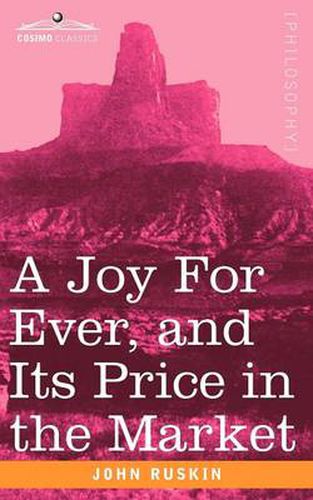Readings Newsletter
Become a Readings Member to make your shopping experience even easier.
Sign in or sign up for free!
You’re not far away from qualifying for FREE standard shipping within Australia
You’ve qualified for FREE standard shipping within Australia
The cart is loading…






This title is printed to order. This book may have been self-published. If so, we cannot guarantee the quality of the content. In the main most books will have gone through the editing process however some may not. We therefore suggest that you be aware of this before ordering this book. If in doubt check either the author or publisher’s details as we are unable to accept any returns unless they are faulty. Please contact us if you have any questions.
In all probability the greatest Victorian critic of art and society, John Ruskin had an enormous influence on his age and our own, and like so many Victorians of the age, he had astonishing energy. While carrying on a voluminous correspondence with the intellectual luminaries of his day, he published poetry, children’s literature, and books and essays on geology, botany, church politics, political economy, painting, sculpture, literature, architecture, art education, myth, and aesthetics. A great and successful propagandist for the arts, he did much both to popularize high art and to bring it to the masses as evidenced in this volume containing two essential public addresses from 1857 on The Discovery and Application of Art and The Accumulation and Distribution of Art. Included here are Ruskin’s Supplementary Additional Papers: . Education in Art . Art School Notes and . Social Policy. ALSO AVAILABLE AT COSIMO CLASSICS: Ruskin’s Political Economy of Art JOHN RUSKIN (1819-1900) was born in London, the only child of prosperous, self-made parents who collected art and encouraged their son’s literary activities. Throughout his life, his writings on art had an immense influence on British, European, and American architecture and industrial design. Ruskin’s immense body of literary works include Modern Painters, Volume I-IV (1843-1856); The Seven Lamps of Architecture (1849); The Stones of Venice, a collection of essays published between 1851 and 1853; Unto This Last (1862); Munera Pulveris (1862-3); The Crown of Wild Olive (1866); Time and Tide (1867); and Fors Clavigera (1871-84).
$9.00 standard shipping within Australia
FREE standard shipping within Australia for orders over $100.00
Express & International shipping calculated at checkout
This title is printed to order. This book may have been self-published. If so, we cannot guarantee the quality of the content. In the main most books will have gone through the editing process however some may not. We therefore suggest that you be aware of this before ordering this book. If in doubt check either the author or publisher’s details as we are unable to accept any returns unless they are faulty. Please contact us if you have any questions.
In all probability the greatest Victorian critic of art and society, John Ruskin had an enormous influence on his age and our own, and like so many Victorians of the age, he had astonishing energy. While carrying on a voluminous correspondence with the intellectual luminaries of his day, he published poetry, children’s literature, and books and essays on geology, botany, church politics, political economy, painting, sculpture, literature, architecture, art education, myth, and aesthetics. A great and successful propagandist for the arts, he did much both to popularize high art and to bring it to the masses as evidenced in this volume containing two essential public addresses from 1857 on The Discovery and Application of Art and The Accumulation and Distribution of Art. Included here are Ruskin’s Supplementary Additional Papers: . Education in Art . Art School Notes and . Social Policy. ALSO AVAILABLE AT COSIMO CLASSICS: Ruskin’s Political Economy of Art JOHN RUSKIN (1819-1900) was born in London, the only child of prosperous, self-made parents who collected art and encouraged their son’s literary activities. Throughout his life, his writings on art had an immense influence on British, European, and American architecture and industrial design. Ruskin’s immense body of literary works include Modern Painters, Volume I-IV (1843-1856); The Seven Lamps of Architecture (1849); The Stones of Venice, a collection of essays published between 1851 and 1853; Unto This Last (1862); Munera Pulveris (1862-3); The Crown of Wild Olive (1866); Time and Tide (1867); and Fors Clavigera (1871-84).